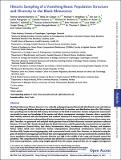Por favor, use este identificador para citar o enlazar a este item:
http://hdl.handle.net/10261/348218COMPARTIR / EXPORTAR:
 SHARE SHARE
 CORE
BASE CORE
BASE
|
|
| Visualizar otros formatos: MARC | Dublin Core | RDF | ORE | MODS | METS | DIDL | DATACITE | |

| Título: | Historic Sampling of a Vanishing Beast: Population Structure and Diversity in the Black Rhinoceros |
Autor: | Sánchez-Barreiro, Fátima; Cahsan, Binia de; Westbury, Michael V.; Sun, Xin; Margaryan, Ashot; Fontsere, Claudia CSIC ORCID; Bruford, Michael W.; Russo, Isa-Rita M.; Kalthoff, Daniela C.; Sicheritz-Pontén, Thomas; Petersen, Bent; Dalén, Love; Zhang, Guojie; Marqués-Bonet, Tomàs CSIC ORCID ; Gilbert, M. Thomas P.; Moodley, Yoshan | Palabras clave: | Ancient DNA Black rhinoceros Conservation genomics Population genomics |
Fecha de publicación: | 1-sep-2023 | Editor: | Oxford University Press | Citación: | Molecular Biology and Evolution 40(9): msad180 (2023) | Resumen: | The black rhinoceros (Diceros bicornis L.) is a critically endangered species historically distributed across sub-Saharan Africa. Hunting and habitat disturbance have diminished both its numbers and distribution since the 19th century, but a poaching crisis in the late 20th century drove them to the brink of extinction. Genetic and genomic assessments can greatly increase our knowledge of the species and inform management strategies. However, when a species has been severely reduced, with the extirpation and artificial admixture of several populations, it is extremely challenging to obtain an accurate understanding of historic population structure and evolutionary history from extant samples. Therefore, we generated and analyzed whole genomes from 63 black rhinoceros museum specimens collected between 1775 and 1981. Results showed that the black rhinoceros could be genetically structured into six major historic populations (Central Africa, East Africa, Northwestern Africa, Northeastern Africa, Ruvuma, and Southern Africa) within which were nested four further subpopulations (Maasailand, southwestern, eastern rift, and northern rift), largely mirroring geography, with a punctuated north-south cline. However, we detected varying degrees of admixture among groups and found that several geographical barriers, most prominently the Zambezi River, drove population discontinuities. Genomic diversity was high in the middle of the range and decayed toward the periphery. This comprehensive historic portrait also allowed us to ascertain the ancestry of 20 resequenced genomes from extant populations. Lastly, using insights gained from this unique temporal data set, we suggest management strategies, some of which require urgent implementation, for the conservation of the remaining black rhinoceros diversity. | Versión del editor: | https://doi.org/10.1093/molbev/msad180 | URI: | http://hdl.handle.net/10261/348218 | DOI: | 10.1093/molbev/msad180 | ISSN: | 0737-4038 | E-ISSN: | 1537-1719 |
| Aparece en las colecciones: | (IIBB) Artículos (IBE) Artículos |
Ficheros en este ítem:
| Fichero | Descripción | Tamaño | Formato | |
|---|---|---|---|---|
| msad180.pdf | 1,34 MB | Adobe PDF |  Visualizar/Abrir |
CORE Recommender
PubMed Central
Citations
2
checked on 18-abr-2024
SCOPUSTM
Citations
2
checked on 26-abr-2024
Page view(s)
22
checked on 28-abr-2024
Download(s)
8
checked on 28-abr-2024

